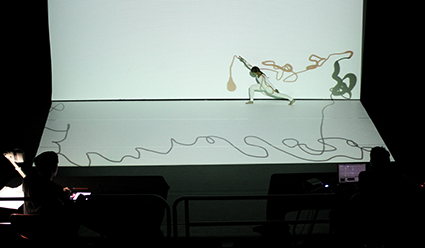March 2015
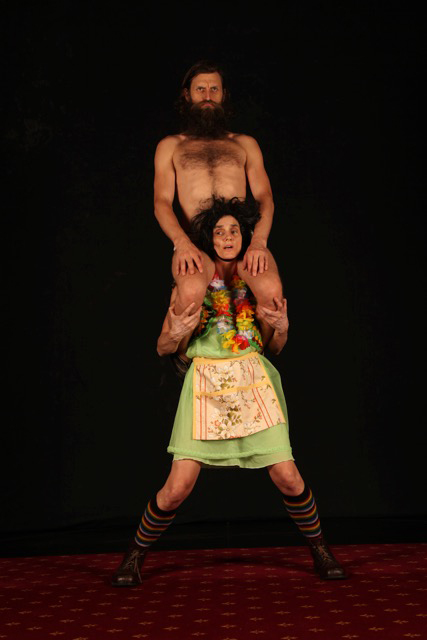
Jo Lancaster, Simon Yates, acrobat
photo Karen Donnelly
Jo Lancaster, Simon Yates, acrobat
ACROBAT HAVE A NEW SHOW, TITLED IT’S NOT FOR EVERYONE. THE COMPANY OCCUPY A SPECIAL IF UNUSUAL PLACE IN THE HISTORY OF CIRCUS IN AUSTRALIA. ON THE ONE HAND, THEY ARE GREATLY ADMIRED WITHIN THE PERFORMING ARTS COMMUNITY FOR THE EXCEPTIONAL RIGOUR OF THEIR PERFORMANCES AND A SPARE, BARELY ADORNED, EVEN FERAL AESTHETIC. ON THE OTHER, NOT MANY AUSTRALIANS HAVE HAD THE PLEASURE OF BEING THRILLED BY THEM. THEIR SUCCESSFUL CAREER HAS LARGELY PLAYED OUT, WITH EXCEPTIONALLY GOOD REVIEWS, IN EUROPE.
In an insightful article for RealTime in 2006 about acrobat’s Smaller. Cheaper, Poorer, erstwhile Circus Oz performer Anni Davey interviewed observers Mike Finch, Teresa Blake and Karen Hadfield about their responses to the skills on show, the unsophisticated theatricality and apparent ‘artlessness’ side by side with calculatedly potent imagery. I saw the show in 2007—at times it looked like circus mutating into performance art given the singular attention each of the three solo performers dedicated to image making.
Excerpts from various performances by acrobat scattered across YouTube reveal spectacular acrobatic and aerial work, while a short film of moments from Propaganda (2010) indicates a playful theatricality, mocking everyday life in the West as if it has been Stalinised and then gone wildly out of control. It’s funny, but can turn dark: a woman with a mermaid’s tail is suffocated by a large plastic bag as she struggles to scale a rope—a distressing image of drowning in a polluted ocean.
Simon Yates and Jo Lancaster are acrobat. They’ve worked with various collaborators over the years, but their latest show, It’s Not for Everyone, premiering for Albury Wodonga’s HotHouse Theatre in March, is a two-hander. I talked with Lancaster, by phone, about the show’s title and the company’s move towards a greater theatricality.
A potential audience member might regard the title with some suspicion. Why did you go there?
I suppose some people might look at it and think this show is too weird or that it’s not proper theatre and not want to come because they might not have a good time. Others might have their curiosity piqued and wonder, “Is it for me?” If someone comes with that sort of curiosity, I think that’s a perfect attitude to see this performance.
I gather this time because of Simon Yates’ back injury that you’ve left behind some of the acrobatics and you’re moving in a more theatrical direction.
I’d like to think we’re going further into the ‘physical theatre’ direction—though that’s a dicey term—rather than less. We’re dialling up on the theatrical element, which has always been in our shows but in the past it’s been scaffolded with impressive circus feats and beautiful acts. So we’ve been able to be quite experimental, cheeky and subversive in what we present on stage. We’ve been able to get away with it because we’ve had that kind of impressive stuff in the background so people can go, “Ooh it’s a bit weird but isn’t it great how they can do that.” That’s becoming the meat of the show. Simon does have a sore back but he’s a very pointy-end physical performer. He can still do silly physical things. We’re deliberately trying not to do really difficult stuff because we’re trying to move away from circus to become more [performance] artists, I guess.
In what I’ve seen of Propaganda there’s a strong element of physical clowning and quite a bit of business. The publicity for the new show suggests it’s about clowning. In another interview you mentioned that sometimes old acrobats become clowns. How does this relationship between acrobatics and clowning manifest in the new work?
It doesn’t feel like so much an ageing thing as clowning being one of our acrobat things. And as for getting old, well, we’re still full of energy. Simon has fragility in his back but I’ve seen teenagers in shin splints. You can get an injury at any age and it slows you down. So we’re both energised and excited about this new show. It feels like a new direction that’s going to bring out new things in us. We’ve been so dedicated to our craft of acrobatics that it really hasn’t left much space for other things to develop.
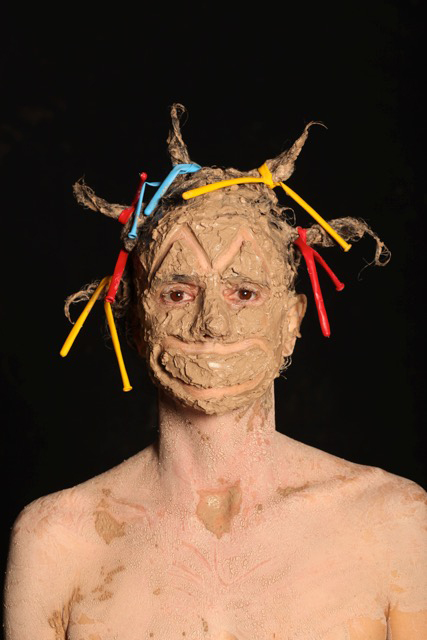
Jo Lancaster, acrobat
photo Karen Donnelly
Jo Lancaster, acrobat
Has there always been an element of clowning in acrobat’s work?
I think so. An acrobat is at their best when they’re the most stupid. It’s important for an acrobat not to think too much. It gets in the way. That sort of stupidity has bled into the theatrics of our shows. We have a bit of a preference for stupidity in our theatricality. Silliness and stupidity—it’s a style I’d like to think we’ve perfected.
In Propaganda there are some marvellous moments where routines seem to go wrong and there are terrible falls and crashes, people landing crotch to shoulder.
Tragedy is one of our favourite elements.
The promotion for the show suggests that you want to push clowning into a surreal dimension. Clowning is already surreal but you want to make it even stranger?
Well, I would put it a bit differently. The clowning is very much the accessible end of the show. The opening is highly accessible, which, again, is “not for everyone.” Some people prefer inaccessible art. But generally speaking, people love clowns and a classic circus act and happy, fun times. That’s where the show opens. But quite quickly we lose the clowns and the show unravels. It becomes darker and darker. There’s some dark clowning that goes on but really what happens is that we’re trying to pull the audience into a more alien world, to bring them with us and connect with them along the way. More and more we become aliens but hopefully we do it in such a way that we don’t ‘alienate’ people.
Into what kind of alien world are you taking the audience? Is it a reflection of the uncertain world we currently live in?
I don’t want to give away too much—though I’m sure the secret will come out soon—but at the end, we’re quite foreign, alien beings.
Are you human beings?
Oh yes, we’re human beings.
What’s driving this vision?
I think we just want to see how far we can bring the audience with us, have people test themselves to see how far they’re willing to go to appreciate something.
Is this a dark vision of reality?
I hope not. It’s just that the things that Simon and I perceive as funny start out being very obvious and predictable, but over time things are less obvious and less predictable. So, there’s some darkness to it but it’s not harsh or dystopian.
It’s just strange?
It’s strange.
Is there a sense that you believe the world had gotten out of hand and you’re trying to represent it in some way that’s kind of amusingly surreal?
We’re definitely pointing at things along the way but in a more abstract sense and hopefully with humour. I am personally quite optimistic about things. I feel like we can rise above these difficulties. It’s entirely possible. I don’t want to bring everybody down. I prefer to have a laugh at the less pleasant things that happen.
HotHouse Theatre, acrobat, It’s Not for Everyone, Wodonga, March 19-29.
RealTime issue #125 Feb-March 2015 pg. online
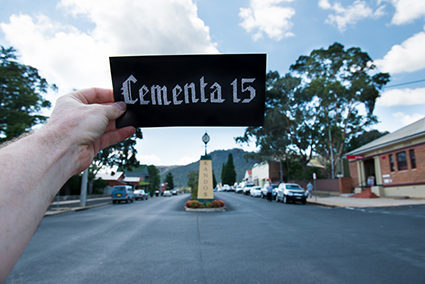
Photo courtesy Cementa 2015
ACROSS THE BLUE MOUNTAINS ON THE BYLONG VALLEY WAY, 235KM NORTH-WEST OF SYDNEY, IS THE SMALL TOWN OF KANDOS, APPROXIMATELY HALFWAY BETWEEN LITHGOW AND MUDGEE. WITH A POPULATION OF 1,300, UNTIL 2011 THE TOWN WAS A CENTRE FOR CEMENT MANUFACTURE FROM LIMESTONE QUARRYING AND THIS YEAR WILL SEE THE CESSATION OF COAL MINING IN THE IMMEDIATE REGION. WHERE THERE WAS CEMENT AND COAL, NOW THERE’S ART, WHETHER IN THE FORM OF THE KANDOS ANNUAL BOB MARLEY FESTIVAL IN MARCH OR IN APRIL, CEMENTA, THE SECOND OF A BIENNIAL FESTIVAL OF CONTEMPORARY ART OF ALL KINDS.
Co-directors Ann Finegan, Alex Wisser, Christine McMillan and Georgina Pollard have curated an immersive four-day program rich in new forms and cultural diversity, featuring an impressive list of 60 local and visiting artists, Indigenous and non-indigenous, and crossing the great divide between city and country. As well, say the directors, “We will celebrate the beautiful little town that graciously hosts our festival…Artists will exhibit and perform in shop windows and garages, in pubs and churches, in community and scout halls and vacant blocks across the town.”
Liz Day is creating a field of mushrooms knitted by local craftspeople. Indigenous artist Aleshia Lonsdale from Mudgee “will be making a work of concentric circles using earth and different materials to represent the stages of encounter and transformation since first settlement,” and Jason Wing will use “native birdsong to evoke relationship to country.” Wade Marynowsky’s Acconci Robot appears to be a large, plain, human-height box, but when ignored it has a life of its own.
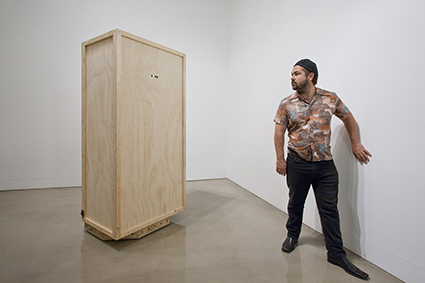
Wade Marynowsky, The Acconci Robot, 2012 An Experimenta Commission RMIT Gallery, Melbourne
Photo © RMIT Gallery
Wade Marynowsky, The Acconci Robot, 2012 An Experimenta Commission RMIT Gallery, Melbourne
Other artists of the many in the program include Alan Schacher, Karen Therese, Renny Kodgers and The Twilight Girls, Robyn Backen, MR & MRS Brown, John Conomos, Daniel Mudie Cunningham, Nola Farman, Daniel Green, Alana Hunt, Lucas Ihlein, Jumaadi, Fiona MacDonald, Ian Milliss, Sean O’Keefe, Juilee Pryor, Eugenia Raskopoulos, Josephine Starrs and Leon Cmielewski, Justene Williams, Alex Wisser and Yiorgos Zafiriou.
Word about the first Cementa in 2013 spread quickly. Doubtless, the second, much-expanded iteration will attract an even larger audience of locals and visitors eager to embrace new experiences in sound art, installation, performance, electronic art, music, street art and more: artist tours, workshops, and evenings dedicated to sound, poetry, cabaret and film in a unique setting. RT
Cementa 15, Kandos, NSW, 9-12 April, www.cementa.com.au
RealTime issue #125 Feb-March 2015 pg. online
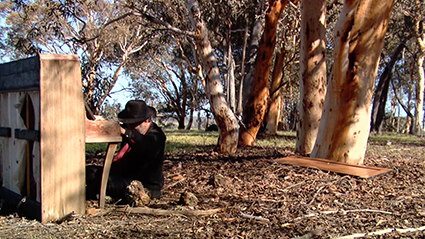
Ross Bolleter
photo courtesy Totally Huge New Music Festival
Ross Bolleter
TOS MAHONEY, THE INDEFATIGABLE ARTISTIC DIRECTOR OF WESTERN AUSTRALIA’S TURA NEW MUSIC (“FOR THOSE WITH A SOUND APPETITE,” QUIPS THE WEBSITE BANNER) HAS SPENT 25 YEARS NURTURING WA MUSIC AND HAS PRODUCED 12 TOTALLY HUGE NEW MUSIC FESTIVALS, FEATURING NEW MUSIC AND SOUND ART FROM ACROSS AUSTRALIA AND THE WORLD BUT ALWAYS WITH A WELL-WARRANTED COMMITMENT TO WA COMPOSERS.
Tura advocates for and produces new music as well as providing resources (playing a key archival role as you’ll see below), operates Club Zho, Sounds Outback and regional and remote residency programs. It also produced the remarkable Crossing Roper Bar collaboration between the Australian Art Orchestra and the Young Wagilak Group from Ngukurr, Arnhem Land, for which it won the Outstanding Contribution to Australian Music in a Regional Area Award in the Australian Music Centre’s 2009 Classical Music awards. A new tour of the project was staged by Tura in 2013.
Tura’s Totally Huge New Music Festivals draw together an impressive range of composers, great players and diverse audiences. I met with an upbeat Mahoney is Sydney recently to discuss his 2015 program.
Do you have an overall theme or vision for this year’s Totally Huge?
Vision but not theme—never theme. It’s always amazing how connections end up happening. I’d be quite interested to write something at some stage about the synchronicity of opportunism. I mean opportunism in a positive sense, not in an exploitative or lazy way but effective managing of curating opportunities often ends up with really interesting both connections and juxtapositions that are sometimes, I think, not there when people start out with “Well, we’re gonna have it all about theme X.” So to a degree, if there’s a theme to Totally Huge it’s an ongoing one of eclecticism and juxtaposition.
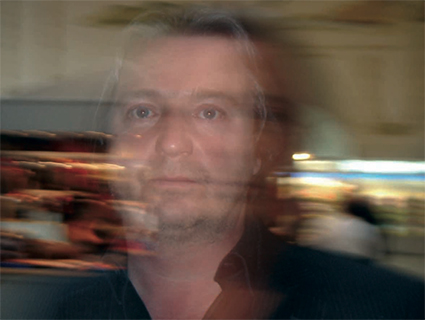
Johannes Sistermanns
photo Stefan Fricke
Johannes Sistermanns
I see German artist Johannes S Sistermanns is your featured guest with an installation-performance-sound work, SpaceFolding SoundPlastic.
He’ll come about four weeks before the festival, doing a residency at the PS Art Space, a fantastic newish independent art space in Fremantle. He’ll make a series of sound and performance installations there. And Decibel has commissioned him to write a new work so they’ll be collaborating with him. The performance will open the festival.
A young Perth composer and sound artist, Steve Paraskos, will curate Successor 2, a night of immersive works including his own and others by Kynan Tan, Cat Hope and Sam Gillies. That’ll be in the foyer of the State Museum—the last event in that building before it closes for renovations over the next six or so years.
Another German artist, Friedrich Gauwerky, a great cellist who collaborated with Stockhausen, is doing a program of works by Stockhausen. There’ll also be another new work by Sistermanns.
I see that London-based Australian piano virtuoso Zubin Kanga will be “exploring the potential for multiple identities, malevolent doppelgängers and mysterious landscapes in music that expands the sonic and visual capabilities of the piano.”
Zubin’s presenting Dark Twin at the Art Gallery of Western Australia featuring a new work commissioned from Cat Hope alongside works by Michel van der Aa, Peter Ablinger, Steve Reich and Australians Daniel Blinkhorn and Julian Day.
Alice Hui-Sheng Chang from Melbourne is a Taiwanese-Australian voice/sound artist. She uses extended vocal techniques with electronic treatments. One will involve a large group of people she’ll be working with: it’s site-specific and choral almost but not in any traditional sense. The last concert, Time Alone, will be from Sydney percussionist Claire Edwardes with locals Ashley Smith who’s a clarinettist and Louise Devenish a percussionist with works by Lindberg, Muhly, Ligeti, Sydney’s Michael Smetanin and Damien Rickertson and Perth’s Christopher Tonkin.
The program also includes the launch of a significant archive.
We were partners in an ARC grant with Edith Cowan University as the principal and the State Library and also ABC Classic FM and the National Library to set up an online WA New Music Archive covering 1970 to the present. It’s been a fraught couple of years but it’s now exponentially on the way. So on the Wednesday night of the festival, we’re going to launch the site. This will be a first draft almost but we want to get it online and get people feeding back. The site will have audio and video.
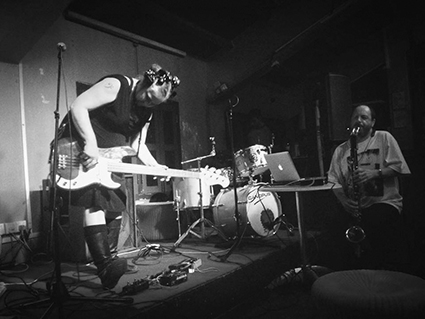
Decibel
photo courtesy Totally Huge New Music Festival
Decibel
Who are some of the artists we’ll find on the site?
Roger Smalley, Ross Bolleter, Alan Lamb, Cathie Travers, Lindsay Vickery, Iain Grandage, Cat Hope and lots, lots more.
A young composers night is a bit of a tradition within the festival. This year we have a whole new flock of composers basically out of the University of Western Australia (UWA) and the West Australian Academy of Performing Arts (WAAPA). I’m hopeful that we’ll hear some exciting new work.
Another project that’s been going on for a long time is one by filmmaker Robert Castiglione who has been documenting ruined piano artist Ross Bolleter’s work over 12 years (“I found myself filming and recording pianos in an incredible variety of locations – on roof tops, in a dam, in a lonely field or perched precariously on a granite outcrop!). “We’ll be presenting the premiere of Invitation to Ruin at Totally Huge.
On Thursday there’ll be a symposium connected to the Archive Launch around WA art music from 1970 to now—pretty broad but making connections.
What kind of role, for those of us outside WA, have Tura New Music and Totally Huge played in sustaining an audience for the kind of work you support?
Oh, pretty essential really. Even within what you’d regard as a niche area of practice there are all these different areas—within that broad church that is new music. Even within the program we’ve discussed, there are different audiences. The Steve Paraskos night, for example, that’s a different audience, a younger one than the Zubin Kanga, whom you can market to the classical or the hip classical crowd. And the Sistermanns event is one that might attract more of the visual art/performance crowd.
But to answer your question, because there’s been a continuing line, the Tura line, there are a lot of people who stay in touch, who don’t necessarily come to everything but who stay connected and who’d be the first to say that the information flow, the connection with the area of practice is is through Tura and if they didn’t have that, they wouldn’t know what was going on.
For reviews of the 2011 and 2013 Totally Huge New Music Festivals go to www.realtimearts.net/features
Tura New Music, 2015 Totally Huge New Music Festival, 15-24 May, Registrations for Symposium due 15 April.
RealTime issue #125 Feb-March 2015 pg. online
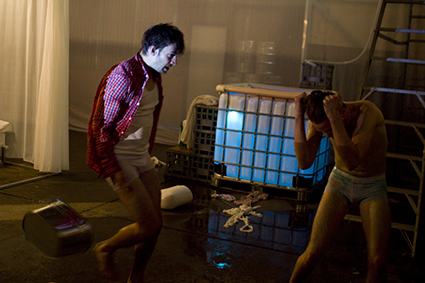
Michael Bevitt, Gabriel Partington, For the Love of an Orange, Crack Festival 2014
photo Amy Theodore
Michael Bevitt, Gabriel Partington, For the Love of an Orange, Crack Festival 2014
Crack Theatre Festival sprang nine years ago from the National Young Writers’ Festival program of This is Not Art (TINA), a festival held every two years in Newcastle. Crack Co-Artistic Director Finn O’Branagain explains: “the program event had received a lot of submissions from performance writers and makers that didn’t quite fit. It’s called Crack because it caught all the things that fell through the Writers’ Festival cracks.”
Crack sees itself as “Australia’s most experimental contemporary performing arts gathering” (press release) which might be news to Next Wave, FOLA (Festival of Live Art), exist-ence, Junction and Proximity. But Crack has good reason to be proud, not least for its support for boundary-busting young and emerging artists from across the country making their first steps towards joining the ranks of experimental practice. As its Co-Artistic Directors O’Branagain and Hannah Strout write of the festival, its forums and workshops, “This is an opportunity for practitioners seeking a community of like-minded peers that will form a national network.”
Unlike large city-based fringe festivals, Crack neither charges artists fees to be programmed nor its audiences for tickets. The aim is for artists to “gain valuable feedback, performance experience and a safe space to try new ideas.” For the second year Crack’s triennially funded Setting the Stage initiative will provide financial assistance to one work from each state and territory in Australia to present at the festival.
Refreshingly most of the artists in Crack are not well-known, but their biographies frequently reveal high level training in theatre, IT, visual arts, music, psychology and the school of hard knocks as well as travel and apprenticeship. Works in the 2014 sound fascinating: “One typewriter. Hundreds of voices. Witness the Frankensteined Monologues, a stitched and sutured experiment in exquisite corpse theatre. Discover the story that you helped write in this shared group reading”. Or Project ’84: Part One, “an interactive exploration of an Orwellian inspired future, performed spontaneously through precise, synchronized instructions delivered to participants’ mobiles.”
RealTime spoke with O’Branagain about how she came to the festival, the vision for the event and its structure.
How long have you been involved?
Three years now. I got involved when I first came to TINA when I was 19. I grew up in Darwin and my idea of what constituted art was very much smaller as you can imagine. TINA blew my mind, literally changed my life. I met people who were doing amazing projects I never imagined possible around Australia. I went back to Darwin and thought I need to do that—I need to see more. So I started travelling, did different things and then in 2012 the opportunity to work with Crack came up so I applied and started working on it in 2013 and it’s been the most rewarding role. To be able to work with so many emerging and experimental artists is so exciting, to see every year the things they come up with.
And you share the role of Artistic Director?
Yes, it’s a two-person role. We’re such a small team we end up doing so much more than simply curating. We’re the general managers, the curators—we deliver the festival. Hannah and I are so lucky to have each other. We’ve become really close friends as well. This year we have two Associate Producers, which is fantastic. They’re so driven and have such different backgrounds. It’s wonderful to now have a strong core team of four, to which we’ll later add our Production Manager.
How important is the experimental aspect of the performances?
It’s quite important, especially for the artists. For many reasons, people who are making experimental work don’t often get a chance to show it to a mainstream audience. That’s often the case in fringe festivals as well. Fringe festivals are fantastic but for artists they come at a financial risk. The fact that we’re free for artists to participate in and free for audiences to come to means that artists can show their riskiest works, they can try out pieces that they’re not quite sure are working yet or they’re not quite sure how they’ll go. We’re a safe space. Audiences that come are often artists themselves or they’re people who are interested in work that’s pushing the boundaries in form or content. They become a community that cares about the work they’re doing and they have a chance to present in a way where they’re not going to lose money. They’re just going to gain experience. That’s been really important.
Do you get a good turnout to respond to these works?
Absolutely. We get around 2,000-2,500 audience members each year.
I was looking over the 2014 program and there’s an incredible diversity of forms including a lot in the live art vein.
It’s the liveness that we’re really after. That comes across even in the works that are more visual art oriented or installation—they have a live element to them. The audiences can interact and the artist is right there talking to them and ‘performing.’
As in Hapticity, 10.00-4.00pm daily in 2014?
Yes, That was Robbie Karmel with a fantastic participatory drawing project. I think he’s since gone on to publish a book of his work, The Drawing of Bodies and Things.
You also had an audio walk.
Josephine Were arrived a few months before and spoke to local people about what their wishes were for the future of Newcastle. As you walked through the streets she described over headphones the people she’d spoken to, what they looked like and thought. You really got a sense that they were with you, that you were talking with locals. There was a sense of their ownership of the town and how they felt about it.
How does the Setting the Stages initiative work?
This is something we’re really proud of and we’re hoping we can expand in future. At the moment Australia Council funding allows us to support one artist or artist group from each state and territory to come to the festival. We pay their fares, accommodation, per diems and an artist’s fee. Ideally we’d like to offer at least an artist’s fee for all of our artists but this project is a really good opportunity for us to prove to the funding bodies and to Australia that when you can financially support artists, the quality of work and the experience for the artist are really enhanced.
What’s the age group of the artists participating?
Generally they’re quite young but this can vary. Last year, I think our youngest artists were about 19. The median age I’d say would be about 25. We had some more senior artists, the oldest in her 50s. We’re really happy we attract a range of ages and people at different stages of their careers from early to mid to established artists.
Do you curate the event from the applications?
We do. Last year we had double the number we had the year before. This year, we’re expecting more again, which is fantastic. We’re sad to have to turn people away but it’s great that the process is becoming more competitive and we’re able to offer opportunities to diverse artists so we can create a special experience for an audience. We can also pick out different trends and issues from the applications we receive. This informs the talks, the forums, the panels and classes. We can create opportunities for the artists who are coming that will be relevant to their practice. RT
Go to Artist Information Pack and Application Form. Applications close 11:59PM Monday 30 March.
Crack Theatre Festival, This is Not Art, Newcastle, 1–4 Oct (October Long Weekend).
RealTime issue #125 Feb-March 2015 pg. online


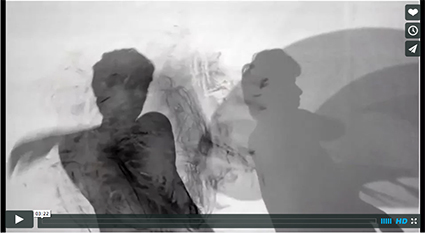
,_2014.jpg)
.jpg)
